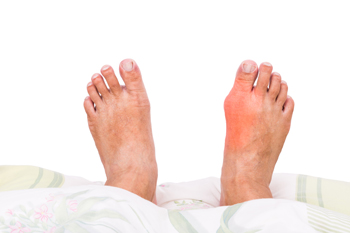Reasons Bunions Can Develop

The location on the foot where a bunion generally develops is the bottom of the joint in the big toe. It can happen due to genetics, or if an injury has occurred. The bony protrusion of a bunion that develops in this area may cause the big toe to shift toward the other toes, and the foot may look deformed. Many patients have to purchase larger shoes to accommodate the shape of the foot. Additionally, walking may be uncomfortable, and limping may help to alleviate the discomfort. Mild relief may be found when the affected foot is soaked in warm water, and it may help to wear a protective pad over the bunion. Effective prevention methods of bunions can include avoiding wearing high heels, wearing shoes with bigger toe areas, and by developing strength in the feet with a routine exercise regime. If you have developed a bunion, it is advised that you schedule an appointment with a chiropodist who can effectively treat this condition.
Bunions progressively worsen over time and may cause walking in your shoes to become difficult. To learn more about bunions, please consult with one of the chiropodists from The Footcare Centre. Our chiropodists will assess your condition and provide you with quality foot and ankle treatment.
What Are Bunions?
A bunion is a bony bump that protrudes from the base of the big toe. Bunions are caused due to a misalignment of the first metatarsal. The characteristic bump of a bunion forms when the metatarsal shifts outwards from its proper position. Bunions develop slowly over time and progressively worsen without treatment. The skin over the bunion may develop calluses due to the friction from shoes. Eventually, a bunion can make walking uncomfortable or even painful. Bunions are one of the most common foot deformities and are especially common in women and older adults.
Symptoms
A bunion appears as a bulging bump on the outside of the base of the big toe.
The bunion may also:
Be swollen, red, or sore
Develop corns or calluses over it
Cause pain
Limit the big toe’s range of motion
Treatment
There are several different treatments available for bunions. Conservative treatment options include wearing shoes with a wider toe box, cushioning the bunion with a specialized pad, wearing shoe inserts, icing the bunion if it becomes inflamed, and taking medications to relieve pain. In more severe cases, more invasive procedures may be done. This may involve removing the swollen tissue around the bunion, straightening the big toe, realigning the bones at the front of the foot, or a combination of these procedures.
If you have any questions, please feel free to contact our office located in . We offer the newest diagnostic and treatment technologies for all your foot care needs
